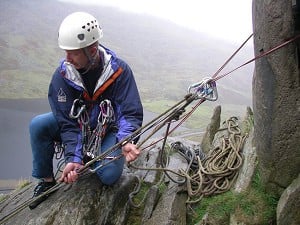
In part 4 of this short video series, Steve Long shows how to prusik up a rope.
Prusiking up a rope is a potentially dangerous activity as it loads the system, and can easily cause rope abrasion from edges of rock. Before starting to climb a rope you should make a thorough risk assessment starting from the assumption that an alternative solution such as an easy climb is usually preferable.
The ability to climb a rope is most likely to be required as a complementary skill to abseiling. Once committed to a descent, if problems arise such as abseiling the wrong line or failure to climb out, re-ascending via the abseil rope may be the only way out. This option is only available of course if the abseil rope has been left in place.
To ascend a rope, two sliding clutches are needed. For unplanned evacuation these will probably be two of the prusik loops that you carry on your harness at all times. Some people carry light gadgets such as tiblocs or rope-men for this contingency. For sea-cliff approach abseils and for following aid pitches you might choose to carry mechanical devices such as jumars. If these are only carried for emergency contingency they can be left attached to the abseil rope while you climb.
The basic system for rope ascending is the same whatever equipment is used.( For long free-hanging pitches such as re-ascending fixed lines on big walls there are more efficient methods but these require more equipment or time to set up). Fix two clutches to the rope. If prusik loops are used a Klemheist is recommended for the top prusik at least, being relatively easy to slide but locking well when required. The top prusik should ideally be attached directly to the harness, while the bottom prusik should be long enough to be used as a foot-loop –this may require an additional sling to be attached. A further sling can be used to attach this prusik back to the harness for back-up should the top attachment fail for any reason.
Tension the rope by slipping the prusiks up the rope as far as they can go, and then alternately pump the leg prusik and waist prusik until the rope is fully taught. Stand in the leg loop and slide the waist prusik as high as it will go. Then relax the leg and hang by the waist, allowing the leg prusik to be slid up as far as possible. Repeat the process. The length of the leg loop should be adjusted so that the steps feel comfortable because overstepping is both strenuous and inefficient.
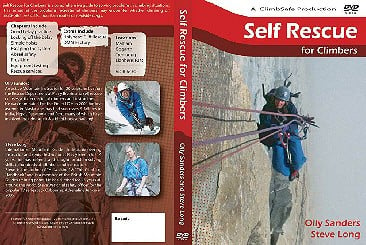
Self Rescue for Climbers DVD
Aimed at recreational climbers, Self Rescue for Climbers is a comprehensive guide to solving problems encountered in such situations as multi pitching in the mountains, sea cliffs or roadside crags. The DVD's format enables the viewer to access relevant information quickly, providing a basic toolbox of techniques which can be applied in any situation.
With scenarios filmed on famous climbs in locations including Malham, Gogarth, the Llanberris Pass and Tremadog, Self Rescue for Climbers is not only 90 minutes of expert instruction, but also a stunning tribute to the possibilities available to the recreational climber in North Wales.
Buy here from www.safetysteve.co.uk
- REVIEW: North Wales Limestone - the Definitive Guide 30 Jun, 2023
- REVIEW: North Wales Limestone 22 Sep, 2014
- Thermo Half Zip from Marmot 18 Sep, 2013
- REVIEW: Mammut RescYou Crevasse Rescue Device 19 Mar, 2013
- Metolius Contact Training Board 23 Jan, 2013
- WC Ropeman #2 - Ascending from Free-hanging 17 Oct, 2012
- COMPARISON REVIEW: Lightweight Alpine Mountaineering Boots 4 Oct, 2012
- Wild Country Ropeman How To #1 - Ascending the Rope 2 Oct, 2012
- REVIEW: DMM Alpha Trad Quickdraws 24 Sep, 2012
- Montane Medusa 32 Rucksack 24 May, 2012

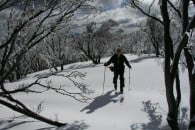


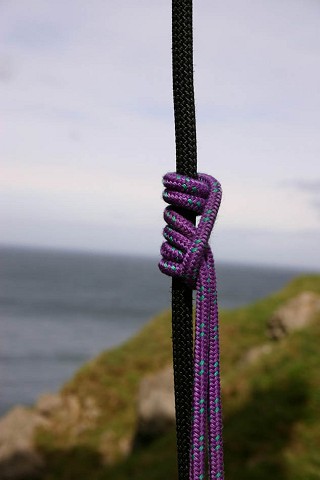
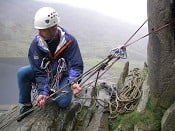
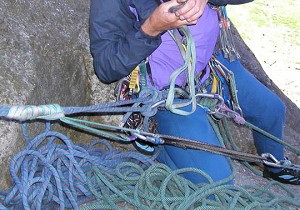
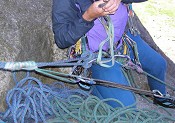
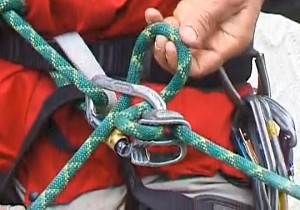
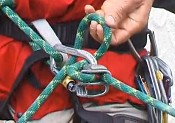






Comments